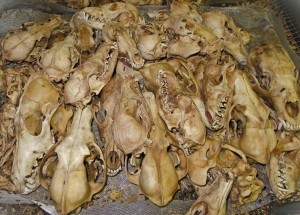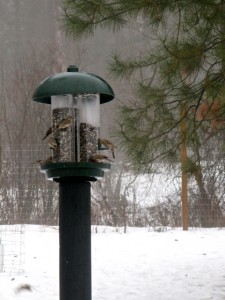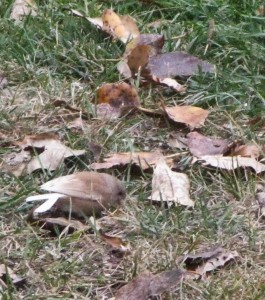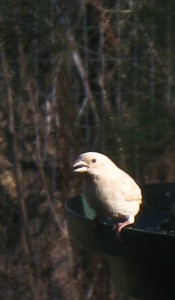Spring green waits patient
in its icy hibernaculum
thaw a distant dream.
Last fall, when Ted had a successful hunt and filled our freezer with elk meat, we wanted to do something to honor the magnificent animal that would provide us with a year’s sustenance. We were not interested in making a trophy of it, that is not the spirit with which Ted hunts, so a head mount was out of the question. Instead we took the skull to Big Sky Beetleworks where it was cleaned by a colony of dermestid beetles.
Dermestid beetles are a species of carrion beetles used by museums, taxidermists, schools and wildlife agencies to clean bones. Gary Haas, who runs Big Sky Beetleworks was kind enough to let me watch the beetles in action. He took me into a room which is temperature controlled–the beetles can’t fly below 80 degrees–and protected from the infestations of other insects, such as spiders which readily feed on the beetles. 
The tiny bugs were swarming over several trays of small mammal and bird skulls, some provided by trappers and others by wildlife agencies. The rotted flesh and ammonia smell was heady. Haas doesn’t have a sense of smell anymore, but the stench stayed lodged in my nostrils for days. Still, I couldn’t resist the chance to see the beetles at work.
Three months later our elk skull was finished. People have always had a fascination with skulls and bones. As Mark Elbroch says in his guidebook, Animal Skulls, “The diversity and complexity of life is ever apparent in the equally varied and beautiful forms that are animal skulls. For skulls are sculptures in a vast array of shapes and textures that excite and inspire our imagination.” Ever since Neanderthals, people have used skulls in rituals and ceremonies. Artists have used the sculptural quality of bones in their work, probably most famously Georgia O’Keefe, whose bone paintings from the desert country first initiated me into an appreciation of bone’s beauty. She said, “When I found the beautiful white bones on the desert I picked them up and took them home…I have used these things to say what is to me the wideness and wonder of the world as I live in it.”
In many medieval and renaissance paintings, a human skull is depicted as a “memento mori”, a reminder of our own mortality and impermanence. For Ted and me, the elk skull which hangs above the entrance to the kitchen is a daily reminder of our dependence on the earth for our very survival, the interconnectedness of all creatures and our gratitude to this elk for our daily nourishment. Looking at the skull I silently repeat the zen Buddhist meal gatha:
First, Seventy two labors brought us this food. We should know how it comes to us.
Second, as we receive this offering,we should consider whether our virtue and practice deserve it.
Third, as we desire the natural order of mind to be free from clinging, we must be free from greed.
Fourth, to support our life, we take this food.
Fifth, to attain our way we take this food…
My last blog post for 2012. One year of trying to capture, in words and photos, the small moments of wonder that have captivated me in the backwoods, at the homestead and beyond. Keeping the blog has been inspiring in much the same way as keeping a field journal, with the added benefit that I have been able to share it with others and hear their own stories in response.
Whenever I go out to the woods now, I find that my experience is deepened in the recording of it. I pause, look harder, try to note all the details so I can recreate the experience for my reader. I make note of the weather, the feelings of cold in my bared fingers as I struggle to retrieve my camera, or the heat of the sun on the top of my head at noon-time. I know that the heron or the squirrel are feeling that too, the heron fluffing up his down in the icy wind, or the squirrel seeking refuge from the summer’s heat in the shady, breezy crotch of the uppermost branches.
I will sniff the fissures in the ponderosa bark for the sweet vanilla scent of sap and know by the intensity whether or not the sap has started rising in the spring. I will taste the ripening huckleberries that scent the forest in the mid-afternoons of August with their sweet baking pie smells, and pucker my lips at the bitter flavor of buffalo berries.
I listen for the sound of wings when a shadow darts across the meadow and wonder at the stealthy silence of the Great Horned Owl as he passes overhead, or thrill to the deep pulsing thrum of the heron as he heads to the river, looking for all the world like a pterodactyl with his long neck crooked in.
And I don’t just notice the blooming of a wildflower, but will look deeper at it’s leaves, maybe the small and thick skinned leaves of an alpine plant designed to conserve moisture, hugging close to the earth before a radiant, heat producing rock.
I experience it deeply so that when I write about it in the blog I can attempt to make my reader feel, hear, see, smell and taste the wild. And in the writing I go deeper still, finding connections and insights I would have missed had I just let the experience pass.
Finally, I have rejoiced in the feedback from you, my readers, some of you close friends who share similar experiences with me or will add to what I know with your own specialized knowledge. Or perhaps you are someone I don’t know and you have just stumbled across my blog and that is always a thrill, to make a connection to another curious naturalist in another part of the country or the world. It is exciting and inspiring to share in your own beautiful poetry or stories and see your homeland through your eyes in your creative photography.
So to all of you who have read this blog over the last year I thank you and I encourage you to comment and share over this next year so we can, as Barry Lopez says, “create an atmosphere in which the wisdom inherent in the world becomes apparent.”
 Every once in awhile in my reading I stumble upon a new trailhead with a path to a destination I’ve not been on before. I may tuck it away in my memory as something to try another time, but there are some words that are so intriguing that I find myself wandering up their paths without a second thought. This quote from Elizabeth Bishop is one such trail: “I’d like to retire…and do nothing, or nothing much, forever…look through binoculars, read boring books, old, long, long books, and write down useless notes, talk to myself, and, foggy days, watch the droplets slipping, heavy with light.”
Every once in awhile in my reading I stumble upon a new trailhead with a path to a destination I’ve not been on before. I may tuck it away in my memory as something to try another time, but there are some words that are so intriguing that I find myself wandering up their paths without a second thought. This quote from Elizabeth Bishop is one such trail: “I’d like to retire…and do nothing, or nothing much, forever…look through binoculars, read boring books, old, long, long books, and write down useless notes, talk to myself, and, foggy days, watch the droplets slipping, heavy with light.”
Just hours after copying those words in my commonplace book, I found myself on the couch in the living room, trying to squeeze in a bit of reading before a jumbled day of meetings and errands. The constant fluttering around the birdfeeder kept drawing my eye up from the page and I watched as the magpies and flickers bullied the flocks of house finches and chickadees away from the seeds and up into the apple tree where the smaller birds could only perch in frustration while the aggressors feasted on the bounty.
I laid my book aside and went to fetch my binoculars. I read a few more pages and then saw the magpies being chased off the ground by the chickens. Do the chickens realize the magpie sitting on the feeder is flicking great scatterings of seed on the ground for them? In between magpies and flickers, the swarms of chickadees, house finches, nuthatches, juncoes and a bird I didn’t recognize crowded the feeder and foraged on the ground. They made it look like the leaves had come alive in an unseen wind as they hopped about.
I went to fetch my bird book and then picked up my reading again, waiting for the mystery birds to return. A few more pages and there they were, savanna sparrows, a bird I had seen often enough, but never had a name for. A couple of squirrels made a foray from the trunks of the apple tree and cottonwood, freezing every time they caught a hint of movement that might be the dog. They were tentative around the chickens who ignored them unless they got too close. Then the chickens turned and chased the squirrels off, looking like sumo wrestlers as they waddled after the offenders.
I glanced at the clock. It was too late to make it into town for my meeting. I called to let them know I wasn’t coming and returned to the couch. Suddenly the whole day lay ahead of me, with nothing that couldn’t be put off until tomorrow. Could I really spend the day doing nothing but reading and watching the little dramas playing out at the feeder? I recalled Bishop’s words. Maybe I could.
A downy woodpecker was dividing his time between the bark of the apple tree and the feeder. The mourning doves arrived in a flock of seven and foraged on the ground, flashing the white feathers of their tail like white-tailed deer as they soared over the fence.
Deep into my reading, it was awhile before I looked up again and then realized that I had missed a death. I saw the flicker tossing what looked like feathers out of the base of the feeder. So I went out to investigate. Sure enough there were half a dozen small downy gray feathers with white ends tipped with black. A couple more were still in the feeder tray. Had a hawk come down and snatched a small bird? I had watched last year as a hawk had grabbed a red-winged blackbird from the ground and then ripped it’s belly open, pulling out the entrails as if feeding on a plate of spaghetti. If it was a hawk, then surely my chickens were in danger. But they were clumped up under the ponderosas, scratching beneath the carpet of pine needles in search of grubs and I decided they were fairly safe under the net of needled branches.
It struck me as an odd coincidence that as this small unnoticed death occurred I was reading in my book, Sacred Paths and Muddy Places about death: “Ignore death and I would have to ignore life…Every moment of every day, something was born, something grew and something died and what died spawned the next seed of the next birth.”
Another new bird scavenged the seeds on the ground. This one had a red head, a dark eye mask, a red belly and white bars on the wings. It was smaller than the house finches who looked quite outsized next to it through the binoculars–a common red poll if my identification was correct. And I wondered because redpolls are not common at all in Montana. Digging a little deeper I discovered that the redpolls seemed to be migrating farther south than usual this year–an irruption across the northern states, much like the snowy owls last year.
It’s funny, I didn’t sit down with the intention to document what was happening at the feeder. I just sat down to be next to the fire and read for a moment. And then my eye got captured by the activity beyond the window. Captured and then captivated. I had no idea there was such an interplay between the various species that gathered to feast. And each new thing, the interaction between the magpies and the chickens, the flicker tossing feathers, the new birds, the red poll and the savanna sparrows, were unexpected discoveries, and a classic example of not trying to find something and so being delighted by the unexpected.
A sudden sqwauking from the branches of the apple tree and there were two flickers, sword fighting with their beaks, thrusting and parrying with flailings of wings. At last one flew off to the pines, the other in hot pursuit. Then the victor flew to the birdfeeder until the vanquished returned and he had to scare him off again. Peering through the binoculars at the feeding flicker I saw, just under his wing, the black and white tipped feathers. So it was a flicker fight after all, and not a death that left behind the scattering of feathers. So many little mysteries and such satisfaction in the solving.
In the evening, just as the last light drained out of the day and the glass doors became mirrors instead of windows, my husband walked into the room, asking what I had done all day. “Nothing,” I replied. “Nothing much all day.”
The first time I spotted it, it drew my eye like a magnet, the way anything unusual or unexpected might. A flash of white amidst the fluttering of grey and brown and the rufus red bellies of house finches. It turned its tail toward me and scooted around the feeder to the back, out of sight, then reappeared on the other side, a creamy white bird I’d never seen before, could not even remember hearing about. I looked again, then ran to get my camera, but when I returned he was gone.
In my eagerness to “capture” this unique bird I hadn’t even paused long enough to notice what kind of beak it had, the shape of it’s body, nor even its size. The image in my mind began to fade until it was nothing but a ghostly apparition.
I grabbed my field guide and began flipping through the pages. In spite of the fact I hadn’t taken notice of even the most fundamental clues in order to narrow it down to family, I was certain I’d have no trouble finding it. After all, how many white birds could there be? I went back and forth through the guide, but discovered only one bird with the right plumage, the snow bunting. But they appeared to be much bigger than the bird I’d seen.
I called my expert birding friend and asked what he thought. His only idea was the Snow Bunting as well, but the more questions he asked the less likely it seemed. “There’s one other possibility,” he said. “It was with a flock of house finches? It might be a leucistic house finch, though leucistic birds are very rare.”
I’d never heard of these albino deviants before and further research revealed that, though rare, leucistic variants existed for nearly all species of birds.
In leucistic birds the plumage lack melanin pigment caused by a genetic mutation. Sometimes the white patches are small and result in a kind of piebald appearance. Sometimes most all of the feathers are affected resulting in either a very washed out look, or even the total white of an albino. In true albino birds all of the pigments are affected, giving them red eyes and pale beaks, legs and feet
Such birds are rare because their unusual coloring can make them a target for predators. The luecism can also weaken their feathers, since melanin is an important structural component of feathers. These diminished feathers aren’t as insulating and can reflect heat, which makes it hard for the birds in the icy cold of Montana winters. Their unusual plumage also makes it hard for the birds to attract a mate and pass on their genetic mutation.
No one knows what causes this mutation, but an article in the Houston Chronicle cites a study done after the meltdown of Chernobyl in 1986. There was tenfold increase in the incidences of leucism in barn swallows near the plant.
 I never saw the leucistic finch again that winter, but this winter another small, pale bird showed up at the feeder with a flock of juncos . This time it did have some coloring, though very washed out and it’s tail was pure white. I resisted the urge to run for my camera the first time I saw it and instead studied it through the binoculars until it flew off into the backwoods. It continued to show up with the other juncos for several weeks, but I haven’t seen it since December.
I never saw the leucistic finch again that winter, but this winter another small, pale bird showed up at the feeder with a flock of juncos . This time it did have some coloring, though very washed out and it’s tail was pure white. I resisted the urge to run for my camera the first time I saw it and instead studied it through the binoculars until it flew off into the backwoods. It continued to show up with the other juncos for several weeks, but I haven’t seen it since December.
 However, just before Christmas another white bird caught my eye and this one was with a flock of house finches. I studied it carefully, noting it’s size, shape and beak and determined it was indeed a leucistic house finch, though it is doubtful if it was the same one I spotted last year. And this one appears to be a true albino, with its white beak and pale legs and feet.
However, just before Christmas another white bird caught my eye and this one was with a flock of house finches. I studied it carefully, noting it’s size, shape and beak and determined it was indeed a leucistic house finch, though it is doubtful if it was the same one I spotted last year. And this one appears to be a true albino, with its white beak and pale legs and feet.
Which leads me to wonder—why, with luecism being so rare, have I now seen three such birds in just a little over the year? The finch has been returning to the feeder regularly and this time I was finally able to get a picture of him. But I learned my lesson. Look first—really look, and then, if there is an opportunity, try to capture it with the camera.